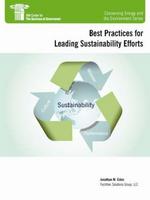
Best Practices for Leading Sustainability Efforts

In attempting to tackle this question and assist government executive charged with wrestling with it, we present a new Center report, Best Practices for Leading Sustainability Efforts, by Jonathan M. Estes.
In October 2009, President Obama signed Executive Order 13514, which outlines leadership efforts the federal government can make to reduce energy consumption and lower greenhouse gas (GHG) emissions. Federal agencies are required to develop strategies, implement and report on projects, and continuously improve their processes as a model for the country.
The Executive Order significantly increased the visibility of sustainability as a strategic imperative for the federal government and beyond, while potentially saving energy and taxpayer money.
Across the federal government, sustainability initiatives are emerging with increasing prevalence. Some examples include:
- The General Services Administration’s (GSA) promotion of green procurement (sustainable supply chains and sustainable suppliers) and high-efficiency green buildings
- The Department of Defense adoption of the term sustainability as a security and energy strategy
- The U.S.Navy’s recent test flight of the Green Hornet, an F-18 powered by 50-percent bio-fuel in anticipation of the deployment of its “Green Fleet”
Given the number of sustainability projects and initiatives underway within most federal agencies, the key question becomes: How should managers in the federal government implement and measure the benefits of sustainable practices?
In attempting to tackle this question and assist government executive charged with wrestling with it, we present a new Center report, Best Practices for Leading Sustainability Efforts, by Jonathan M. Estes.
This report examines the sustainability processes of three organizations -- DuPont, CB Richard Ellis, and the U.S. Army. It also identifies three recommendations that demonstrate the critical success factors for meeting sustainability compliance:
 Connect Sustainability to Mission -- Many organizations are discovering that unless sustainability initiatives are supported at the highest levels and included in the mission and strategic plan, these initiatives fall by the wayside.
Connect Sustainability to Mission -- Many organizations are discovering that unless sustainability initiatives are supported at the highest levels and included in the mission and strategic plan, these initiatives fall by the wayside.
Adopt Cultural Change Strategies – Pursuing culture change is a significant low cost activity with potential for savings and return on investment. A critical success factor lies in the management of cultural change. One way to ensure the initiatives are meaningful and have ubiquitous buy-in across the enterprise is to inspire the staff to come up with ideas in the first place.
Implement Performance Measurement – Build a business case itself to justify the investment while build a measurement model, which has to include an analytics approach to prove the value of your sustainability efforts.
The purpose of this report is to provide practical, timely best practices for public-sector stakeholders and leaders based on independent research from representative organizations. The three case studies were selected because of their long history and continued commitment to sustainable practices and the relevance of their business model for federal agencies as they develop and implement their sustainability plans.
Jonathan Estes’s report complements recent IBM reports and articles: Implementing Sustainability in Federal Agencies: An Early Assessment of President Obama’s Executive Order 13514, by Daniel J.Fiorino, and Analytics and Risk Management: Tools for Making Better Decisions, by Michael J.Keegan.
All of the above reports focus on using better measurement tools for making strategic decisions. These reports together provide a comprehensive spectrum of insights and practical steps derived from best practices in the development and implementation of sustainability strategic plans. They can help managers meet mission goals at the local, state, and federal levels.
We trust that government executives will find useful strategies here for their organization’s sustainability efforts in the years ahead.



